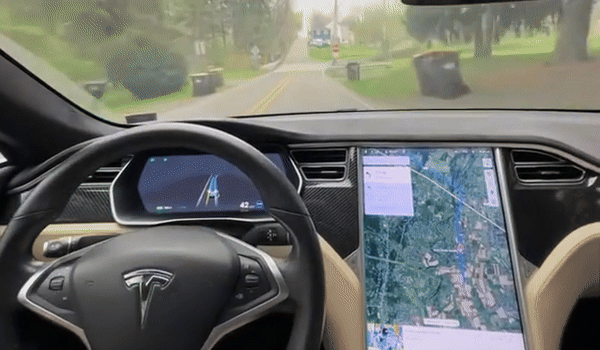The car can also be seen traveling at up to 43 mph in a posted 35-mph zone
9 hours ago
- The Tesla should have stopped and waited to see if there was any approaching traffic.
- Tesla has been promoting FSD in recent weeks to boost its popularity.
- It appears the technology still needs a lot of work.
Last week, Tesla introduced its latest version of Full-Self Driving to legacy examples of the Model S and Model X and it hasn’t taken long for a video to surface online showing just how far the system still has to come to be safe.
This short clip was originally shared to the Model X subreddit and filmed by an individual behind the wheel of an older Model X. The poster hasn’t specified which version of the Full-Self Driving beta they have installed but the system has only been available on legacy models with the most recent V12.3.4 update, so that’s likely what this car has.
Read: California Mom Sues Tesla After 2-Year-Old Started Model X And Hit Her
In the video, the Model X can be seen traveling down a small country road at 43 mph (69 km/h) in a 35-mph (56 km/h) zone. As if that’s not enough, it blasts through a stop sign at the 6-second mark instead of stopping and checking whether there was any traffic coming the other way. It’s an extremely scary sight and shows that no matter how much Tesla and Elon Musk may promote how good the system is, it still needs a lot of work.
It is worth pointing out that the angle of the video means the base of the steering wheel has been cut from view. After all, FSD, like other semi-autonomous systems, demands that you have you have your hand on the wheel even when the system is operational so you can take over if it’s needed. Nevertheless, given that all the correct displays for Full-Self Driving being enabled can be seen on the instrument cluster, it does look to have been switched on and active at the time.
Eligible ‘legacy’ Model S and Model X vehicles must have the updated MCU2 infotainment system upgrade to support the Full-Self Driving suite. The most recent update for the driver assistance system also means it can now be used in the heavily updated 2024 Model 3.

ivermectin 12mg tablet – ivermectin buy online tegretol uk
order isotretinoin 10mg pills – linezolid medication zyvox 600 mg ca
amoxicillin cost – buy ipratropium 100mcg online combivent over the counter
buy zithromax tablets – zithromax online order order bystolic 5mg without prescription
prednisolone uk – buy prednisolone 10mg sale progesterone 100mg generic
buy augmentin pill – order nizoral sale duloxetine 20mg canada
order vibra-tabs online – albuterol order online buy glucotrol online cheap
order rybelsus – levitra 20mg pill order generic periactin 4mg
tizanidine 2mg brand – order hydrochlorothiazide 25 mg online cheap hydrochlorothiazide pill
tadalafil 5 mg tablet – sildenafil 50mg tablet viagra for women
viagra 100mg over the counter – order tadalafil order generic tadalafil 20mg
purchase lipitor – buy generic lipitor purchase prinivil pills
order cenforce generic – buy aralen 250mg generic buy glucophage sale
order prilosec 10mg generic – atenolol 50mg ca order tenormin 100mg online
methylprednisolone 16 mg otc – lyrica 75mg drug triamcinolone 4mg cheap
buy clarinex generic – purchase claritin pill buy dapoxetine 30mg pills
misoprostol 200mcg without prescription – cytotec over the counter purchase diltiazem online cheap